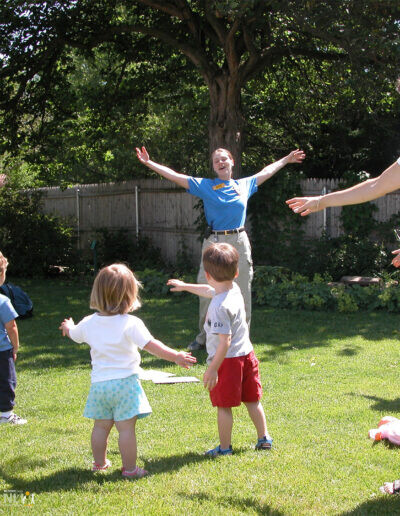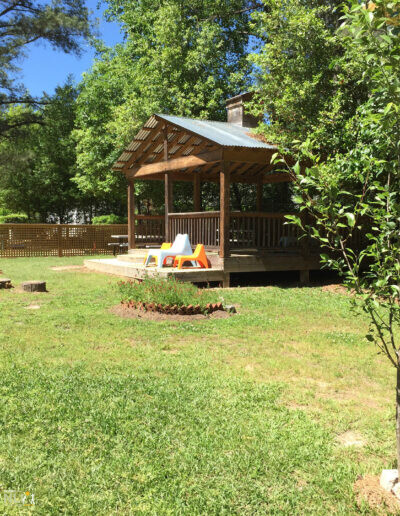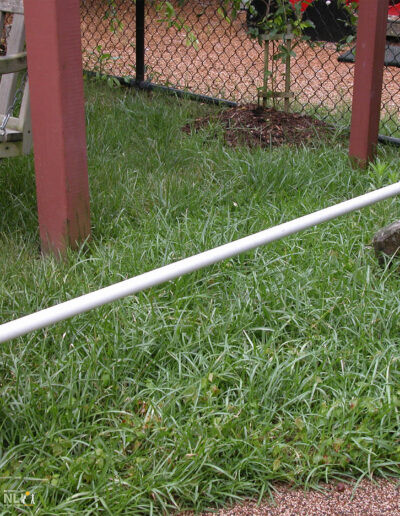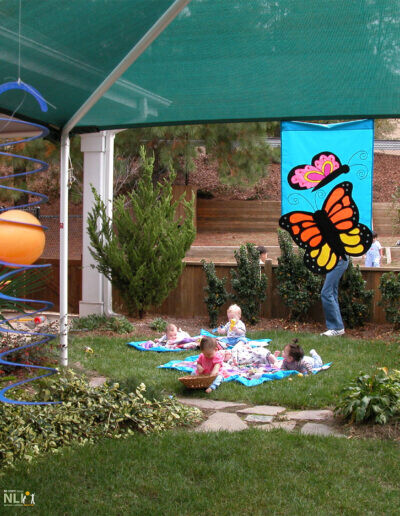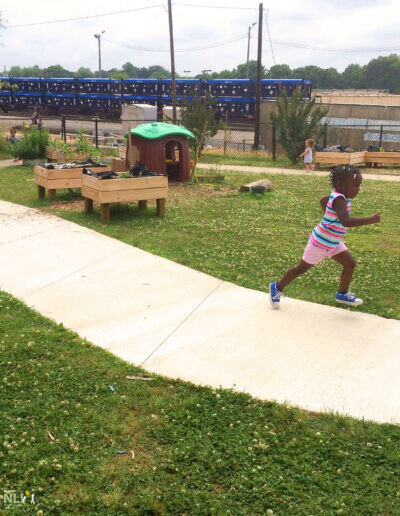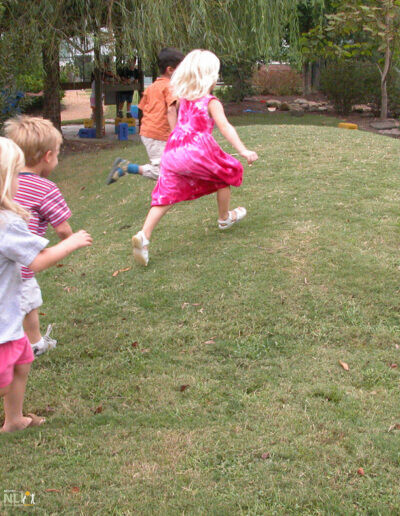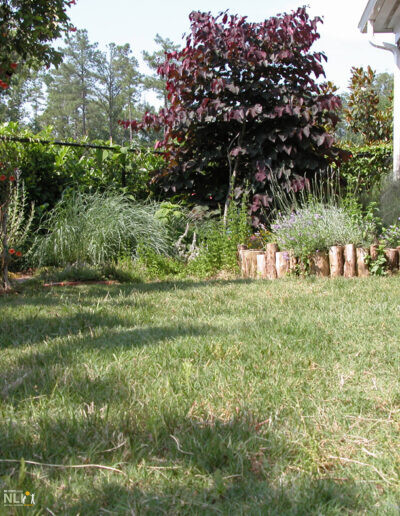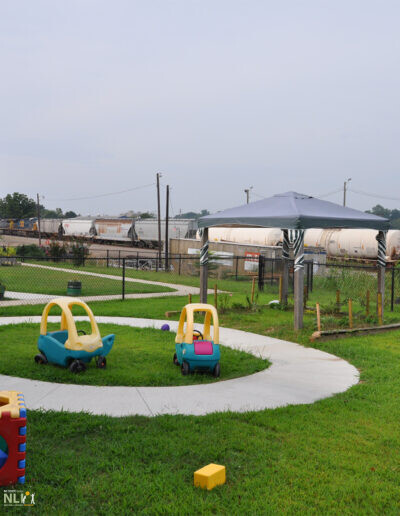16. Multi-Purpose Lawns
Multi-purpose lawns provide a soft surface for active play such as ball games, parachute play, and group activities, as well as a place for quieter activity such as story-time. Undulating ground surfaces and peripheral shade trees, shrubs and/or flowering perennials add play value. Plant Protection Rails with designated entrances can be installed to reduce crisscross pedestrian traffic, which may wear the lawn unnecessarily. May be combined with an adjacent Deck.
Location
Multi-purpose lawns should be in a central location of the outdoor learning environment (OLE) for ease of access. A sense of enclosure will add to the experience of group activities, such as story-time or social games. Best practice is to have the lawn bounded by a curvy, looping concrete pathway to prevent the spread of aggressive grass and create an anchor for active, physical play. The easiest place to grow grass is in full sun: although shade tolerant varieties are available, it’s best to locate lawns in areas that receive 3-4 hours of afternoon sun per day.
Shape
Toddler and preschool lawns should be designed with a naturalistic form, using a circular or semi-circular shape whenever possible. Multi-purpose lawns should have clear physical boundaries with defined edges in order to focus group activities. Looping and curvy adjacent pathways allow for a naturalistic edge.
Size
Infant/Toddler. Size of the lawn depends greatly on the age of children served and their stage of development. Lawns can be less than 100 square feet for children crawling or just learning to walk.
Preschool. In preschool areas, a lawn ranging from 150 to 300 square feet will accommodate the vigorous physical activity of older children, including ball play.
School-age. Lawns should be at least 400 square feet for school-age children. To accommodate this larger size within a limited space, carefully consider the trade-offs between traditional outdoor uses, such as a paved ball area, and a multi-purpose lawn.
Selecting Grasses
Warm season vs. Cool Season. Warm season grasses are green in the summer and dormant (brown) in the winter. Cool season grasses are the opposite, staying green throughout winter months. Consider local seasonal cycles when selecting grass species.
Annual vs. Perennial. Annual grasses are used for temporary lawns and erosion control. Many seed mixes will have a percentage of annual grass to allow for initial establishment. The annual grass provides a boost of green within just a few weeks, but will die out after a season and not return, allowing the perennial grass to establish. Perennial grasses go dormant, but return every year after dormancy.
Clumping vs. running. Clumping grasses grow from a single root system and do not spread, but the “clump” gets larger as the plant matures. Clumping grasses are easier to manage, but require re-seeding and fertilization to maintain a lush green lawn. Running grasses are more difficult to manage: these types of grasses provide thick mats of turf, but often out-compete other plants and end up spreading into nearby garden beds.
Common grass types:
- Fescue is a clumping cool-season grass that has been cultivated in many varieties. There are varieties that are suitable for sunny or shady conditions, but as a general rule, fescue lawns need both sun and shade to thrive.
- Bermuda grass is a common warm-season running grass that is often used on golf courses or athletic fields because of its ability to live in hot, dry conditions. Because this grass spreads so vigorously, it is very popular for low maintenance applications. The danger of planting Bermuda grass, however, is that it can quickly take over outdoor areas, creating a difficult management scenario.
- Zoysia grass is the recommended grass type for high traffic multi-purpose lawns. It is a warm-season running grass that is wear-resistant and forms a thick mat, similar to Bermuda. Zoysia grass is easy to manage and shade tolerant.
Drainage
Good drainage will allow a lawn to dry out at an appropriate rate after rainfall or irrigation. Providing positive drainage is important for lawn health, and will maximize usage through all seasons. Inadequate drainage is the most common reason that new lawns fail. Types of lawn drainage include:
“Run-off” drainage. By very slightly sloping or “doming” the lawn, excess water will flow off of the lawn toward a drainage feature, such as a catch basin or dry stream bed. Slope is defined by the amount of elevation change across a surface. The minimum slope required for this type of drainage (also known as “sheet drainage”) on a lawn is 2% (1/4” change in height per foot), unless combined with another draining method.
Underdrains or “French” Drains. These types of drainage structures are installed below the ground in trenches filled with 1–2″ size gravel. Water travels vertically through the soil and into the gravel pit, entering pipes that are perforated or slotted to allow water in. Underdrainage allows a lawn with less than 2% slope to have adequate drainage.
Successful Establishment
Soil Amendement. High-quality soil is critical to successful lawn establishment. When choosing a grass, test the pH of the existing soil and its ability to drain. The proper soil texture would be considered sandy loam, a type of soil that has less clay and more sand than common soil types. Depending on the pH of the soil, various fertilizers and additives may be needed to keep lawns healthy and beautiful. Till and aerate the desired lawn area, removing any large roots, rocks, and weeds, and mix in compost. If planting in heavy clay or sandy soils, mix 1–2 cubic yards of compost per 1,000 square feet into the top 6–8 inches of subsoil. For further guidance on soil quality of how to test it, contact the local cooperative extension office.
Seeding Times. Seeding is the most economical method of establishing grasses. NCSU Cooperative Extension recommends seedign cool-season grasses in early fall, but fair results may be obtained from seeding in early spring. Warm-season grasses are best planted in late spring and early summer. Unlike cool-season grasses, some warm-season grasses must be planted either by sod or other vegetative means because seeds either are not available or do not result in uniform stands.
Temporary fencing. After seeding or laying down sod, put up temporary fencing around the perimeter of the desired lawn area. This will keep children from trampling on the growing lawn, which may prevent successful establishment.
Watering. To prevent grass from drying out during establishment, keep the top 1.5 inches of the soil moist. This may require light watering two or three times a day for 7 to 21 days.

